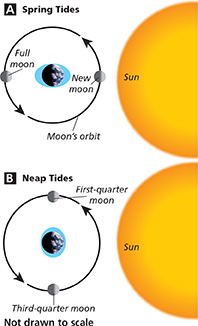Tides on Earth
In Daytona Beach, Florida, people often drive cars along the flat, wide beaches. Occasionally, a driver parks on the beach and returns to find the car covered by the waters of the Atlantic Ocean. The driver is the victim of a rising tide. Tides are the regular rise and fall of ocean waters.
 Tides are caused mainly by differences in the moon's gravitational pull on Earth. Recall that the force of gravity between two objects decreases as the distance between them increases. The gravitational force of the moon pulls more strongly on the side of Earth that faces it, and less strongly on the side that is away from it. This difference causes the entire Earth to be stretched. Because water flows easily, the effect of the moon's gravity on the oceans is much greater than on the solid Earth.
Tides are caused mainly by differences in the moon's gravitational pull on Earth. Recall that the force of gravity between two objects decreases as the distance between them increases. The gravitational force of the moon pulls more strongly on the side of Earth that faces it, and less strongly on the side that is away from it. This difference causes the entire Earth to be stretched. Because water flows easily, the effect of the moon's gravity on the oceans is much greater than on the solid Earth.
The gravitational pull of the moon causes the oceans to bulge at the locations closest to and farthest from it. As Earth rotates on its axis, high tides occur when an area moves through either of these two bulges. Most coastal areas experience two high tides and two low tides each day.
Earth's tides actually slow the planet's rotation. The moon responds by moving away from Earth at an average velocity of about 4 cm per year. Even so, the moon's gravitational effect on Earth is about twice that of the sun. As seen in Figure 10A, during a new or full moon, the sun's and the moon's gravity pull together. This produces spring tides, where the change between daily high and low tides is the greatest. Figure 10B shows that when the moon is in its first or third quarter, the moon and the sun pull at right angles. This produces neap tides, where there is the least change between daily high and low tides.
Figure 10 A During spring tides, the pulls of the moon and sun add together. B During neap tides, the moon and sun pull Earth and its oceans at right angles.

Section 25.2 Assessment
Reviewing Concepts
 Explain why temperatures vary widely between day and night on the moon.
Explain why temperatures vary widely between day and night on the moon. How did lunar craters and maria form?
How did lunar craters and maria form? What do scientists hypothesize about how the moon formed?
What do scientists hypothesize about how the moon formed? Why do the phases of the moon change?
Why do the phases of the moon change? What is the difference between a lunar eclipse and a solar eclipse?
What is the difference between a lunar eclipse and a solar eclipse? What causes tides on Earth?
What causes tides on Earth?
Critical Thinking
Comparing and Contrasting What is the difference between the umbra and the penumbra of a solar eclipse?
Comparing and Contrasting Why are spring tides larger than neap tides?
Math Practice
The gravitational pull on the moon's surface is about one sixth of that on Earth. If a person weighs 700 newtons on Earth, how much would he or she weigh on the moon?
Due to friction caused by the tides, Earth's days are getting longer at a rate of 0.00002 second per year. How much longer will a day be in a million years?




